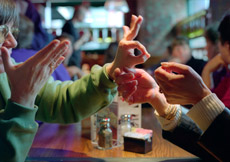
Mariliana Arvelo (Cambridge, MA), “Untitled,” Newton, MA, From the series “Senses,” 2005, C-print, 24 x 30 inches, Courtesy of and copyright Mariliana Arvelo
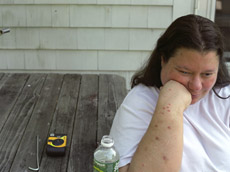
Mariliana Arvelo (Cambridge, MA), Sherry, Pembroke, MA, From the series “Senses,” 2005, C-print, 24 x 30 inches, Courtesy of and copyright Mariliana Arvelo
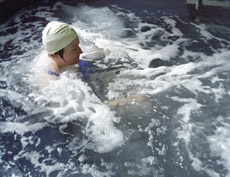 Mariliana Arvelo (Cambridge, MA), “Untitled,” Brighton, MA, From the series “Senses,” 2005, C-print, 24 x 30 inches, Courtesy of and copyright Mariliana Arvelo
Mariliana Arvelo (Cambridge, MA), “Untitled,” Brighton, MA, From the series “Senses,” 2005, C-print, 24 x 30 inches, Courtesy of and copyright Mariliana Arvelo
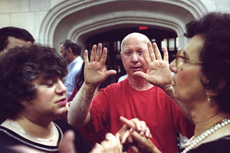
Mariliana Arvelo (Cambridge, MA), Nagala’at performers, II, Watertown, MA, From the series “Senses,” 2004, C-print, 24 x 30 inches, Courtesy of and copyright Mariliana Arvelo

James Patten (Cambridge, MA), “Tactile Photograph” of Mariliana Arvelo’s Sherry, Pembroke, MA, 2005, CNC laser etching on wood, 2005, 15 x 24 inches, Courtesy of the artists

James Patten (Cambridge, MA), “Tactile Photograph” of Mariliana Arvelo’s Sherry, Pembroke, MA, 2005, CNC laser etching on wood, 2005, 15 x 24 inches, Courtesy of the artists
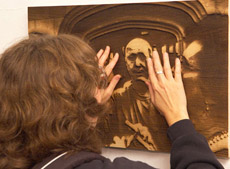
James Patten (Cambridge, MA), “Tactile Photograph” of Mariliana Arvelo’s Nagala'at performers II, Watertown, MA, 2004, CNC laser etching on wood, 2005, 15 x 24 inches, Courtesy of the artists
CURATORIAL STATEMENT
Mariliana Arvelo and James Patten exemplify a unique partnership and approach to social documentary. Arvelo began this project through Jaimi Lard, a remarkable woman who was born completely deaf with almost no vision and works in public relations for the Perkins School for the Blind in Watertown, MA (p erhaps best know for its famous alumna, Helen Keller) . Through Laird, Arvelo was introduced to a larger deaf-blind community centered around the Deaf Blind Contact Center and began to photograph and learn sign language. Based on Arvelo’s compelling color photographs, her partner and husband Patten then designed a computer program to produce a series of photographic reliefs that are truly interactive and educational for people of all abilities.
Born in Caracas, Venezuela, Arvelo graduated in 2002 from the New England School of Photography. Her work has appeared in several international publications and been exhibited at the Danforth Museum of Art ( Framingham, MA), the ARC Gallery ( Chicago, IL), and the Gallery at the Piano Factory ( Boston, MA). Originally from Virginia, Patten has exhibited or performed in venues such as Art Interactive ( Cambridge, MA), Museum of Modern Art ( New York, NY), the Museo Guggenheim Bilbao ( Bilbao, Spain), the Ars Electronica Center ( Linz, Austria), among many other international venues. Patten is currently completing his Ph.D. at the Massachusetts Institute of Technology's Media Lab.
ARTIST STATEMENT: Senses
We have been working with the Boston deafblind community for about a year with the intention of documenting their daily experience and exploring ways that photographs can transcend the visual. The deafblind often use sign language to communicate, but since they cannot see the motions of each other’s hands, they touch each other’s hands to feel the gestures that are usually interpreted visually. The sign language they use is so visually rich that someone who knows nothing of sign language can still grasp the emotional tone of the conversation. With these images we have strived to explore the private, intimate, and beautifully expressive qualities of their conversation.
These wood etchings, or “Tactile Photographs” are created from photographic negatives using a modified CNC laser cutter and custom software that cuts the images into sheets of wood. We exhibit these etchings together with traditional photographic C-prints, giving viewers an opportunity to explore the boundaries between tactile and visual means of perceiving the world.
These etchings are as much about the interaction of gallery visitors with the images as they are about the images themselves. For many in the deafblind community, touching these images has been the first opportunity to experience the medium of photography, including the photographs we have been taking of them for so long. As visitors touch the etchings, over time they begin to show patterns of wear that reveal the routes people have explored with their hands. These patterns, left by many individual finger traces, serve as a record of how people have experienced each photograph as well as a commentary on the primary modality with which deafblind people experience the world. The slowly changing appearance and texture of these etchings over time in response to gallery visitors’ touches forms a subtle interactivity, one in which technology’s role is concealed.
